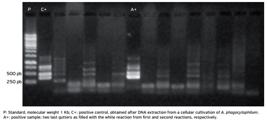ABSTRACT:
Equine granulocytic anaplasmosis is caused by Anaplasma phagocytophilum, a gram negative, obligatory intracellular bacterium, member of Anaplasmataceae family, included in the Rickettsiales order. Little is known about the disease, transmission dynamics, genetic diversity and prevalence in Minas Gerais state, Brazil. This work aimed to do a serosurvey using indirect immunofluorescent assay (IFA) test and evaluation of buffy coat smears, and nested polymerase chain reaction (PCR) as diagnostic methods, to determine the disease situation in horses from two manga-larga marchador breeding farms located in the municipalities of Ataléia e São Vicente de Minas, in Minas Gerais state. It was found that 76% (131/172) of the animals were considered reactive for IFA test, and the total of 12.8% was positive at buffy coat smears analysis. At PCR analysis, it was found 1.94% of the samples positive to the infection. Those samples were sequenced and showed 96% of similarity to A. phagocytophilum from a Ixodes ricinus tick. There is a high frequency of animals with the evidence of contact to A. phagocytophilum on the two evaluated properties in this study, which was proved by positiveness in PCR analysis. New researches must be carried out to better understand the epidemiologic and clinical dynamic of the disease in the state of Minas Gerais.
KEYWORDS:
Horses; serology; immunofluorescence; nested polymerase chain reaction; Anaplasmataceae

 Thumbnail
Thumbnail
 Thumbnail
Thumbnail
 Thumbnail
Thumbnail
 Thumbnail
Thumbnail



